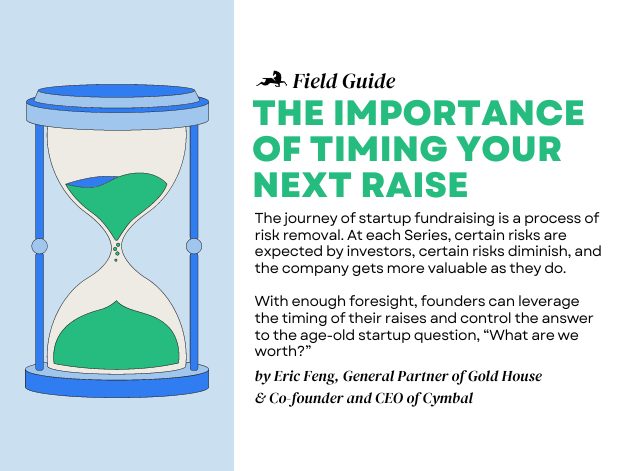The Importance of Timing Your Next Raise
Posted by: Eric Feng
Posted on 07/28/2023

Posted by: Eric Feng
Posted on 07/28/2023

The journey of startup fundraising is a process of risk removal. At each Series, certain risks are expected by investors, certain risks diminish, and the company gets more valuable as they do. With enough foresight, founders can leverage the timing of their raises and control the answer to the age-old startup question, “What are we worth?”
For our first Outlandish Speaker Series, we hosted serial founder and venture capitalist Eric Feng to tackle the importance of timing in fundraising. With a background in computer science, Eric has successfully built and sold three companies and loves investing in the consumer, media, and commerce sectors. He previously led e-commerce at Facebook, led early-stage consumer Internet investments at Kleiner Perkins, and was the founding CTO and Head of Product at Hulu. As of this Field Guide, he is the co-founder and CEO of Cymbal and a General Partner at Gold House.
Here’s how Eric Feng advised founders to think about and time their next round of funding. 👇
–
Marc Andreessen says, “Running a startup is also how I think about raising money — it’s a process of peeling away layers of risk as you go.” And as you peel, always keep your next raise and its potential investors front and center. Investing your energy and runway into minimizing stage-appropriate risks allows you to control the timing and context of your startup’s price.

Eric Feng is the co-founder of Cymbal and Gold House Ventures. With a background in computer science, Eric has successfully built and sold three companies and loves investing in the consumer, media, and commerce sectors. He previously led e-commerce at Facebook, led early-stage consumer Internet investments at Kleiner Perkins, and was the founding CTO and Head of Product at Hulu.
As we explore the unknown of each new investment, our Field Guides are where we document all that we learn along the way.
So, whether you’re actively raising, trying to break into VC, or interested in our game-changing portfolio, our Field Guide's got you covered.
Sign up now for exclusive access to funding opportunities, events/resources from our network of experts, updates from our portfolio, and more!